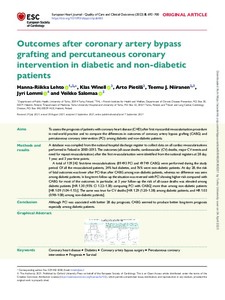Outcomes after coronary artery bypass grafting and percutaneous coronary intervention in diabetic and non-diabetic patients
Lehto Hanna-Riikka; Winell Klas; Pietilä Arto; Niiranen Teemu J; Lommi Jyri; Salomaa Veikko
https://urn.fi/URN:NBN:fi-fe2023040535080
Tiivistelmä
Aims
To assess the prognosis of patients with coronary heart disease (CHD) after first myocardial revascularisation procedure in real world practice and to compare the differences in outcomes of coronary artery by-pass grafting (CABG) and percutaneous coronary intervention (PCI) among diabetic and non-diabetic patients.
Methods and results
A database was compiled from the national hospital discharge register to collect data on all cardiac revascularisations performed in Finland in 2000-2015. The outcomes (all-cause deaths, cardiovascular (CV) deaths, major CV events and need for repeat revascularisation) after the first revascularisation were identified from the national registers at 28-day, 1-year and 3-year time points.
A total of 139,242 first-time revascularisations (89,493 PCI and 49,749 CABG) were performed during the study period. Of all the revascularized patients, 24% had diabetes, and 76% were non-diabetic patients. At day 28 the risk of fatal outcomes was lower after PCI than after CABG among non-diabetic patients, whereas no difference was seen among diabetic patients. In long-term follow-up the situation was reversed with PCI showing higher risk compared with CABG for most of the outcomes. In particular, at three-year follow-up the risk of all-cause deaths was elevated among diabetic patients (HR 1.30 (95% CI 1.22-1.38) comparing PCI with CABG) more than among non-diabetic patients (HR 1.09 (1.04-1.15)). The same was true for CV deaths (HR 1.29 (1.20-1.38) among diabetic patients, and HR 1.03 (0.98-1.08) among non-diabetic patients).
Conclusion
Although PCI was associated with better 28-day prognosis, CABG seemed to produce better long-term prognosis especially among diabetic patients.
Kokoelmat
- Rinnakkaistallenteet [27094]
